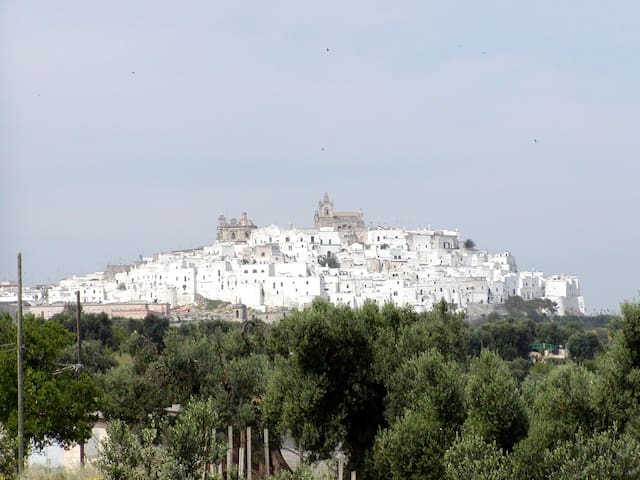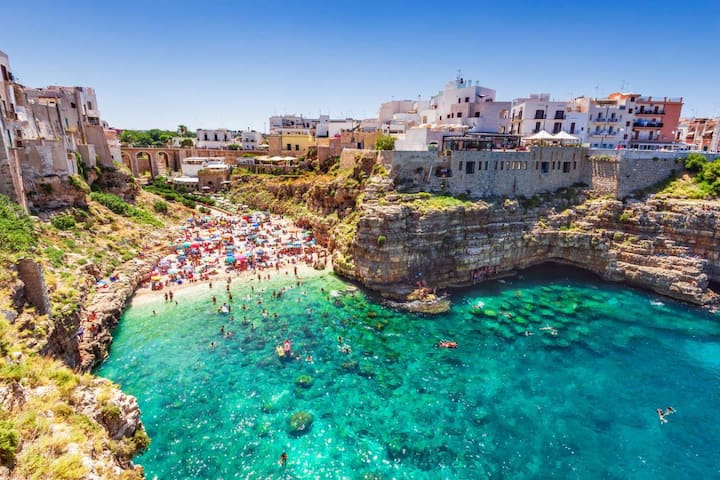Informazioni su Monopoli. Toponimo e storia
Monòpoli, storia della città
Non esiste una precisa origine del suo toponimo, per alcuni "Minòpoli" (da Minosse in greco antico: Μίνως, Mínōs, il Re dei cretesi che avrebbero fondato la città), ma recenti ricerche interpretano le origini del nome dal greco μόνος (mónos, solo) πόλις (póli,città), forse nel senso di città deserta (per altri, "unica").
La città, nata come un anonimo borgo marinaro, è oggi tra gli itinerari turistici più richiesti in Puglia (e in Italia!), famosa anche per essere location di telefilm, fiction e film. Sorge sulla costa dell’Adriatico, a sud-est di Bari, alla cui provincia appartiene. Di origine medievale, ebbe importanza sia con bizantini e normanni, sia con veneziani e spagnoli. Fino al sec. XIX fu il principale centro di esportazione dell’olio dal regno di Napoli. Nel 1443 era tassata per 409 fuochi, nel 1521 per 760. Città vescovile dall’XI secolo.
Una pergamena attestava l’esistenza a Monopoli nel 1340 di una “via degli Ebrei” sita nel quartiere delle ”Chiuse”: in pittagio clodarum in ruga, que dicitur Hebreorum”. Il toponimo tramandava la memoria di un’antica presenza, che il proselitismo angioino probabilmente aveva disfatto sul finire del XIII secolo. Per decenni, infatti, nei documenti prevale la menzione dei neofiti. Così il 22 luglio 1467 i neofiti di Monopoli, insieme con quelli di Taranto, Martina, Ostuni e altre località, ottengono una lettera di remissione generale di qualsiasi crimine commesso fino a quella data. Il 6 dicembre 1469, su querela dei neofiti di Altamura e di Monopoli, re Ferrante I ordinò al percettore provinciale di distribuire agli esponenti solo la misura di sale che essi erano tenuti ad acquistare dal Fisco, senza obbligarli a quantità superiori.
Dalla conquista normanna del Sud italia ai Borboni
Tra l'XI e il XII secolo i normanni segnano la fine dell'impero bizantino, dando vita a una rapida e profonda trasformazione dell'Italia meridionale. Intensificati i rapporti commerciali con Genova, Venezia ed Amalfi, avviate importanti opere difensive, insabbiato l’antico porto e costruito uno più grande, la città acquisì una grande importanza tra i porti dell’Adriatico. Gli Svevi e Federico II, lo "Stupormundi", subentrano ai Normanni dal 1220 al 1248. Monopoli conserverà il titolo di città demaniale anche sotto la dinastia angioina e aragonese. A partire dal 1495 Monopoli viene conquistata dai Veneziani che lasciano numerose impronte nel campo della cultura e del commercio. Ma gli spagnoli, mai domati, si riaffacciano spesso sulla città e in seguito ad alterne vicende, la conquisteranno definitivamente nel 1530, anno in cui Monopoli è venduta da Carlo V - a titolo di baronia - a Pietro Faraone (Pandone da Messina), ma subito riscattata, il 18 aprile dello stesso anno, dai suoi cittadini: per conservare il titolo di città demaniale non asservita ad alcuna nobiltà, i monopolitani pagarono con anelli, ori, argenti e collane la loro libertà, stanchi della nuova dominazione.
Con gli spagnoli, intanto, la città fu fortificata con mura di cinta. È di questo secolo la costruzione del Castello di Carlo V. Il periodo del malgoverno spagnolo, raccontato da pagine di storia, riguardò anche Monopoli.
La parte più bella del litorale barese. Monopoli, le sue 19 calette (spiagge libere) di sabbia e scogliera, rendono questa città tra le più gettonate in Puglia per un turismo di mare.
423 personas locales recomiendan
Monopoli
La parte più bella del litorale barese. Monopoli, le sue 19 calette (spiagge libere) di sabbia e scogliera, rendono questa città tra le più gettonate in Puglia per un turismo di mare.
Famous for its white painted houses, on top of a hill, Ostuni is one of the most fascinating and evocative cities of Puglia. The origins of Ostuni date back to about 2000 years ago, when "Astu-neon" the Greek name of Ostuni, was built on the remains of an even older city. In its two centuries of history the city passed from the dominion of Rome to that of the Ostrogoths and the Lombards. The most flourishing period of its history was the Renaissance following the annexation to the Duchy of Bari, with the revival of arts and culture, followed by a dark period under Duke Giovanni Zevallos and his descendants. The Borboni brought Ostuni to light and, after a history of successive dominations, in 1799 he obtained his freedom. In 1860 it was the first Apulian city to become part of the Kingdom of Italy.
The name White City of Ostuni derives from the color of most of the houses of the city. History and legend mingle on why the houses of Ostuni are of their characteristic white color. One of the causes is for defensive purposes: the inhabitants of Ostuni decided to paint every single house of white to "blind" with the reflected light of the sun enemies willing to attack the city. But at the base there are mainly hygienic reasons. In 1800 the City of Ostini issued an order that obliged all the inhabitants to paint the houses of the old town using white lime. An excellent antitode against infections and diseases that at that time affected the area.
how to get from Monopoli to Ostuni by train: ticket train (online or at the train station, 7.40€ pax a/r)
http://www.trenitalia.com/en.html
886 personas locales recomiendan
Ostuni
Famous for its white painted houses, on top of a hill, Ostuni is one of the most fascinating and evocative cities of Puglia. The origins of Ostuni date back to about 2000 years ago, when "Astu-neon" the Greek name of Ostuni, was built on the remains of an even older city. In its two centuries of history the city passed from the dominion of Rome to that of the Ostrogoths and the Lombards. The most flourishing period of its history was the Renaissance following the annexation to the Duchy of Bari, with the revival of arts and culture, followed by a dark period under Duke Giovanni Zevallos and his descendants. The Borboni brought Ostuni to light and, after a history of successive dominations, in 1799 he obtained his freedom. In 1860 it was the first Apulian city to become part of the Kingdom of Italy.
The name White City of Ostuni derives from the color of most of the houses of the city. History and legend mingle on why the houses of Ostuni are of their characteristic white color. One of the causes is for defensive purposes: the inhabitants of Ostuni decided to paint every single house of white to "blind" with the reflected light of the sun enemies willing to attack the city. But at the base there are mainly hygienic reasons. In 1800 the City of Ostini issued an order that obliged all the inhabitants to paint the houses of the old town using white lime. An excellent antitode against infections and diseases that at that time affected the area.
how to get from Monopoli to Ostuni by train: ticket train (online or at the train station, 7.40€ pax a/r)
http://www.trenitalia.com/en.html
Polignano a Mare is a town on the eastern coast of Puglia, a few minutes by train from Monopoli (strongly discouraged the car, for lack of parking). The main feature of Polignano a Mare is its magnificent location: the old town, in fact, stands on a rocky spur overlooking the Adriatic Sea.
how to get from Namorada1761-Monopoli to Polignano a Mare by train: ticket train (online or at the train station, 2.20€ pax a/r)
http://www.trenitalia.com/en.html
701 personas locales recomiendan
Polignano a Mare
Polignano a Mare is a town on the eastern coast of Puglia, a few minutes by train from Monopoli (strongly discouraged the car, for lack of parking). The main feature of Polignano a Mare is its magnificent location: the old town, in fact, stands on a rocky spur overlooking the Adriatic Sea.
how to get from Namorada1761-Monopoli to Polignano a Mare by train: ticket train (online or at the train station, 2.20€ pax a/r)
http://www.trenitalia.com/en.html
Visite turistiche
Centro storico di Monopoli e dintorni
Uno dei centri storici più visitati dell'area metropolitana di Bari
36 personas locales recomiendan
Centro Storico
Uno dei centri storici più visitati dell'area metropolitana di Bari
Basilica Cattedrale Maria Santissima della Madia
Largo CattedraleCastle of Carlo V
5 Largo CastelloCala Porta Vecchia
Largo PortavecchiaA 37 passi da Namorada1761
Palazzo Martinelli - Meo Evoli
26 Via Orazio ComesMasseria Spina Resort
27 Viale Aldo MoroParco rurale
La Grotta del Trullo, conosciuta anche come Grotta di Putignano, è forse la grotta carsica più suggestiva del territorio pugliese.
Le dimensioni modeste e l'incredibile quantità di stalagmiti e stalattiti, rendono Grotta del Trullo un vero e proprio gioiello di bellezza millenaria.
È l'unica grotta protetta da un trullo ed è la prima grotta aperta al turismo in Puglia.
8 personas locales recomiendan
Grotta del Trullo
SS172La Grotta del Trullo, conosciuta anche come Grotta di Putignano, è forse la grotta carsica più suggestiva del territorio pugliese.
Le dimensioni modeste e l'incredibile quantità di stalagmiti e stalattiti, rendono Grotta del Trullo un vero e proprio gioiello di bellezza millenaria.
È l'unica grotta protetta da un trullo ed è la prima grotta aperta al turismo in Puglia.
Consejos para la ciudad
No te lo pierdas
Il mercato del martedì, via Cosimo Pisonio 88 Monopoli
The large weekly market - every Tuesday - of Monopoli: food, many stalls of clothing (also vintage), vegetables, fruits and vegetables, local products, Apulian ceramics and gastronomy. A nice tour to immerse yourself in the costumes of the Mediterranean (market area, from 8:00 to 13:00 Via Cosimo Pisonio 88 Monopoli)




